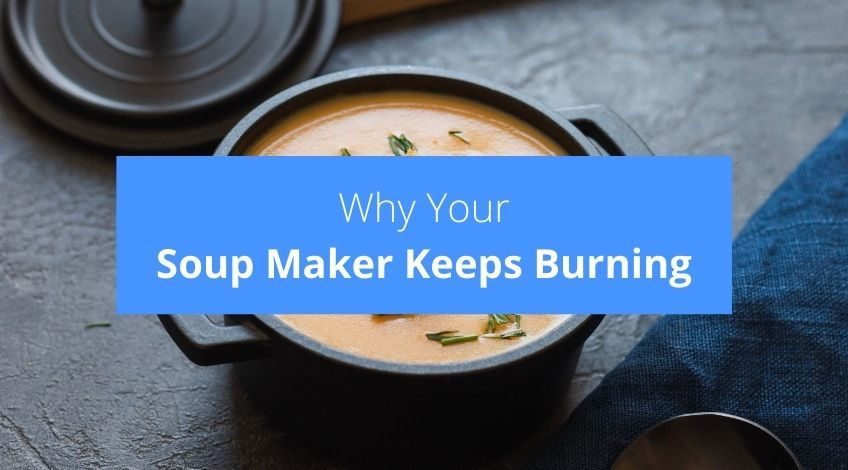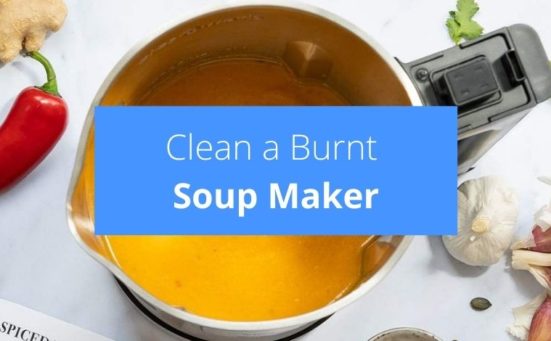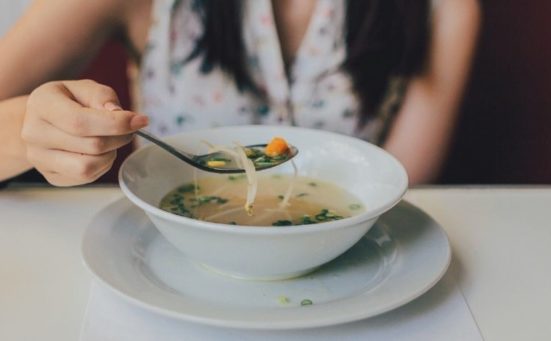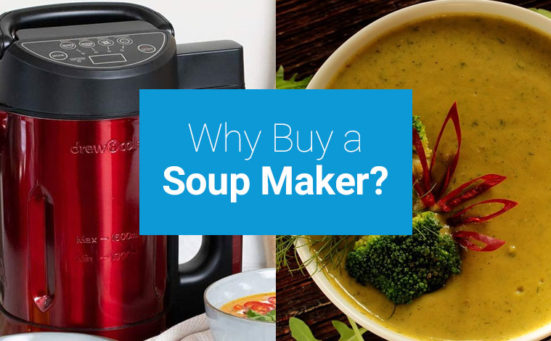
Soup Maker Keeps Burning? This might be why…
Owning a soup maker is a great way to make quick, healthy, nutritious meals, not just soups but smoothies, milkshakes, jams and sauces too. But sometimes when you pour out the soup, the bottom is burnt, this can be a real pain because even if you have a cleaning cycle on your soup maker, it doesn’t always clean it away. We’ll talk about cleaning later, but as the old saying goes, “prevention is better than cure”. So how do we prevent the soup maker from burning at the bottom?
To answer that question fully we need to understand how a soup maker works. Let’s look at the workings of a soup maker really quickly and then get on to preventing it from burning ever again.
Please note: if you’re looking for our soup makers buyers guide, please click here.
How Does A Soup Maker Work?
The easiest way to describe a soup maker is to imagine if an electric kettle and a blender had a baby. Their offspring would be the soup maker, it’s basically an electric kettle with a blender in the lid. The heating element is in the base, and that’s where the burning problem starts.
Unlike a saucepan, it’s not that easy to stir a soup maker as it’s in operation. This can lead to food sticking to the bottom, where the heat is concentrated and eventually burn.
Why Does Food Get Burnt In A Soup Maker
You see, soup makers only have the one set of blades in the lid, so there’s no way of stirring the pot while it’s cooking. Anything stuck to the bottom remains stuck to the bottom and gets burnt on. But there can be other reasons for burnt-on food in a soup maker.
4 Reasons Foods Get Burnt In A Soup Maker

There can be 4 possible causes of foods sticking to the bottom of the soup maker and burning, they are:
- Excessive cooking temperature
Depending on the make and model of soup maker you own, there will be varying cooking temperatures. If you’re finding burnt food regularly, try cooking at a lower temperature and increase the cooking time slightly. - Not stirring the pot
As we said above, it’s not possible to stir the contents of a soup maker while it’s in operation, sometimes, the only way to prevent burning is to stop the cooking process mid-way and stir the contents with a long-handled wooden spoon. - Putting solids in first
This is a sure way to get burnt-on foods at the bottom of the soup maker. We know that many soup maker instruction manuals advise you to add the liquids last, but that’s why food gets stuck at the bottom and burns. As we’ve already established, the heating element is in the base of a soup maker. This means the bottom heats up faster and gets hotter than the rest of the machine. By adding some of the liquid first, you create a slight barrier between the hot surface and the food. - Using thick sauces
The viscosity (thickness) of the liquid will determine the speed at which it burns. Adding undiluted tomato puree for example can cause the bottom of the soup maker to burn. Always dilute thick sauces or add them after the soup has finished cooking.
All 4 of the above reasons have easily solvable remedies but if the worst does happen, how do you remove the mess without any fuss?
What To Do If Burnt Food Is Stuck On The Bottom Of The Soup Maker
If you find yourself in the unfortunate position of having burnt food stuck fast to the soup maker, try filling the machine with hot water, and allowing it to soak. If this doesn’t work, try the following process.
How To Remove Burnt Food From The Soup Maker
To remove burnt-on food from the soup maker follow these easy steps.
- Pour 2 to 3 inches of water into the soup maker
Make sure you cover the burnt-on stain. - Add ⅔ of a cup of biological washing powder
Stir the mixture to ensure the washing powder is diluted into the water. - Leave to soak overnight
Next morning the burnt-on food should be gone. If not just wipe with a non-abrasive sponge or cloth to remove any residue. - Rinse thoroughly
Be sure to rinse thoroughly to remove all traces of detergent, ready for the next batch of soup.
If there is still any burnt-on residue repeat the process but this is not usually necessary. Any biological washing powder will do, it doesn’t need to be the most expensive or any specific brand, it just has to be biological. Be sure to fully remove any suds and residue, and rinse thoroughly before reusing the soup maker.
Soup Maker Cleaning Cycle
Some makes and models have a cleaning cycle to help make life easier. They are easy to use just add a small squirt of washing up liquid to 1 ½ pint of water pour into the soup maker, replace the lid. Select the clean function and wait until it’s finished. This is usually around 4 to 5 minutes.
Frequently Asked Questions
You can put hot or cold water into a soup maker. But we have found it’s better to use hot water as it cooks the food more evenly.
Your soup maker burns at the bottom because that’s where the heating element is. Try adding some of the liquid first, and diluting any thick sauces.
Your soup maker will keep stopping for one of the following reasons, either it’s overfull, or it could be overheating. It is likely to overheat if it has been used for 2 or more cycles continuously.
Also, follow us on Pinterest ...




My soup maker stopped working due to food stuck on bottom